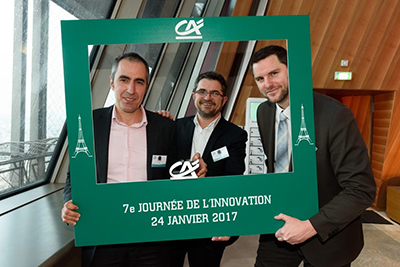Three co-workers wanted their company to support World Community Grid, but they knew they’d need to convince many people to make their vision a reality. Here’s how they did it.
Each year, employees with SILCA (one of the information technology and services arms of Crédit Agricole, an international bank based in France) are invited to submit proposals for new company initiatives at Crédit Agricole’s Innovation Week. In 2015, a small group at SILCA presented a carefully crafted proposal to run World Community Grid on company computers. Their proposal led to a successful pilot project, and eventually a wide-scale implementation that currently includes more than 1,200 computers.

A Carefully Planned Pilot
Social responsibility, environmental responsibility, and solidarity are very strong values within SILCA. So when David Dubius, Philippe Mangematin, and Stephane Douglay learned about World Community Grid several years ago, they realized that this was an opportunity for their organization to donate unused computing power from its desktops for important humanitarian research.
“First, we planned a pilot project that involved 10 computers,” explains David. “We presented a proposal for this pilot project to a jury at Innovation Week 2015, and it was considered one of the best proposals of the year.”
As the IT department for a bank, SILCA is strongly committed to security at every level. To pre-emptively address security questions about World Community Grid, the pilot project team created a proof of concept plan. Their pilot project included communicating frequently with World Community Grid’s development team, and discussing any new security questions as they came up.
The team also showed their colleagues at SILCA how much they could potentially contribute to research projects to combat AIDS, Ebola, Zika, cancer, and other diseases. “We monitored the data flow daily, and turned in weekly reports that detailed exactly what the computers in the pilot project were doing,” says David. They also enlisted the help of Dr. Alessandra Carbone, who led the Help Cure Muscular Dystrophy project. Dr. Carbone, who is based in France, worked with the team to create a podcast where she explained how useful and important World Community Grid was for her research, and for humanitarian science projects in general.
An Award and an Expansion
By January 2017, the team was ready to showcase the results of the pilot project at another Innovation Week. With their presentation “Desktop Grid, Soyons Solidaires,” they received a first-prize Innovation Award out of 60 projects presented within the Crédit Agricole group. Their message, “It’s not just big data, it’s for the good of humanity,” had once again resonated with the Innovation Week judges.
SILCA formalized its collaboration with World Community Grid in December 2016, becoming an official partner and installing the World Community Grid app on 1,200 workstations of its employees.
Plans for the Future
The team is working on internal marketing efforts to continue to spread the word within SILCA, such as working with their communications team to put a World Community Grid widget on SILCA’s intranet site.
The team would like to extend the project to other groups within Crédit Agricole. “SILCA is just one subsidiary of Crédit Agricole,” says David. “We are presenting the results of our project to other groups, and it would be a great victory if others would join.”